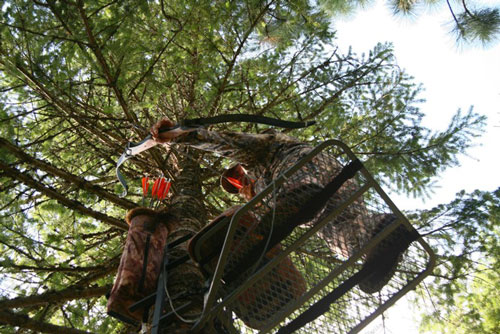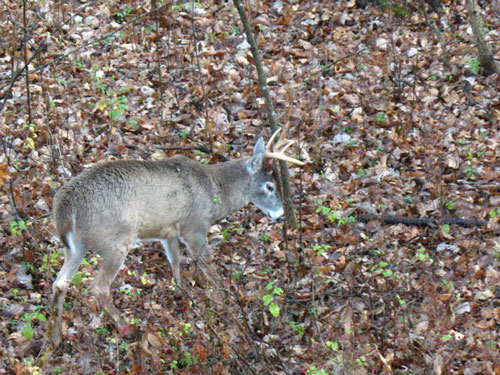 Many outright misses are blamed on string-jumping, the built-in excuse when we’ve simply blown it and our egos wish to believe otherwise. Still, there’s much that’s misunderstood on the subject. The label itself, for instance. Deer are actually ducking the arrow and not jumping at all. String-jumping’s initiated by the noise—your bow’s protest at a sudden release of energy—following release. Instead of jumping, the animal actually coils (drops) or spins (worse-case scenario) to flee perceived danger. Arrows appear to swerve wildly when, in truth, the animal is simply not where it was before the string drop. This movement can be only a few inches or in more substantial increments. Everything hinges on range, bow silence, how alarmed the animal is, and, to a lesser extent, animal size.
Many outright misses are blamed on string-jumping, the built-in excuse when we’ve simply blown it and our egos wish to believe otherwise. Still, there’s much that’s misunderstood on the subject. The label itself, for instance. Deer are actually ducking the arrow and not jumping at all. String-jumping’s initiated by the noise—your bow’s protest at a sudden release of energy—following release. Instead of jumping, the animal actually coils (drops) or spins (worse-case scenario) to flee perceived danger. Arrows appear to swerve wildly when, in truth, the animal is simply not where it was before the string drop. This movement can be only a few inches or in more substantial increments. Everything hinges on range, bow silence, how alarmed the animal is, and, to a lesser extent, animal size.
Game Size Matters
A chucky elk in a wilderness setting is less likely to drop a substantial distance (there are always exceptions) than a dainty whitetail slipping into a pressured Texas corn feeder. In extreme cases an animal might spin so wildly you have little control over where a shot might impact. You get lucky on these deals, like the African impala who took it on his left side when I was initially aiming at his right. But, normally, it ends in disaster—or a lucky miss.
Pressure and Predators Affect Reaction
Some animals are simply jumpier than others. Large predators (large cats in both North America and Africa, wolves, sometimes bears) and heavy hunting pressure naturally put game on edge. This is especially true of the whitetail, an agile and tightly wound game animal that must remain neurotic to survive several hunting seasons. When hunting pressure is minimal and predators are absent, whitetail can prove downright calm, seldom reacting violently to the shot. An animal that has recently sensed you, heard a stand squeak, or smelled you, will more likely react negatively to the shot.
Remember, too, shot noise is arbitrary. What your human ears perceive and what a wild animal hears is no doubt greatly different. It may be more a specific frequency, not raw decibel levels, that spook an animal. For example, a high-pitched ping caused by fall-away rest arm striking a riser may cause a greater reaction than the obvious snap of a released string.
In bowhunting, of course, silence is golden. Today’s bows are ever quieter, but there’s also no such thing as too quiet. Adding every conceivable silencing device available is insurance against a wounding string-jump. Also consider a heavier arrow, one that absorbs more of your bow’s energy instead of transforming it into shot noise. We’ve reached the point in compound technology where sacrificing a bit of speed for the sake of silence certainly won’t affect success.
Anticipate, Aim Realistically
Many bowhunters believe they can beat game on the jump by shooting faster bows. Okay, I’ll buy this to a point. The less time arrows spend en route, the less distance animals can move after reacting to shot noise. Be that as it may, sound travels at about 1,125 fps. That’s three to four times faster than the fastest compound. The fastest game reaction times are calculated in milliseconds.
We’re instructed to aim for middle of lungs, because it’s deadly, and it provides the widest margin for error. When string jumping is a possibility, aiming intentionally low (the heart instead of double lungs) is a safer option. If the animal holds stock still, you’ve made a deadly heart shot, but should the animal drop, the lower hold turns into a lung hit, avoiding “backstrapping” the animal due to a high hit.
Read the Signs, Time Your Shots
 The final piece of the puzzle is proper shot timing. The best shot opportunities are those at calm, unsuspecting animals. This starts with bringing your bow to full draw undetected. Experience is the best teacher, but some hints help. Twitching tails normally indicate an animal is about to lift its head or move forward. An animal’s ears will help as well, swiveling ears indicating a “nervous” deer, relaxed ears a green light to draw. Animals swiveling their ears erratically, more obviously bobbing their heads or stomping feet have detected something. Shooting now is more likely to result in string-jumping than waiting until the animal has settled again. Game with senses temporarily confused—eyesight obscured by obstacles, hearing superseded by wind, attention directed to another animal—offer the best possible shooting opportunities.
The final piece of the puzzle is proper shot timing. The best shot opportunities are those at calm, unsuspecting animals. This starts with bringing your bow to full draw undetected. Experience is the best teacher, but some hints help. Twitching tails normally indicate an animal is about to lift its head or move forward. An animal’s ears will help as well, swiveling ears indicating a “nervous” deer, relaxed ears a green light to draw. Animals swiveling their ears erratically, more obviously bobbing their heads or stomping feet have detected something. Shooting now is more likely to result in string-jumping than waiting until the animal has settled again. Game with senses temporarily confused—eyesight obscured by obstacles, hearing superseded by wind, attention directed to another animal—offer the best possible shooting opportunities.
Preventing string-jumping isn’t beyond your control. Make equipment as quiet as possible and become a student of flawless shot timing, and it should become rare, indeed.






